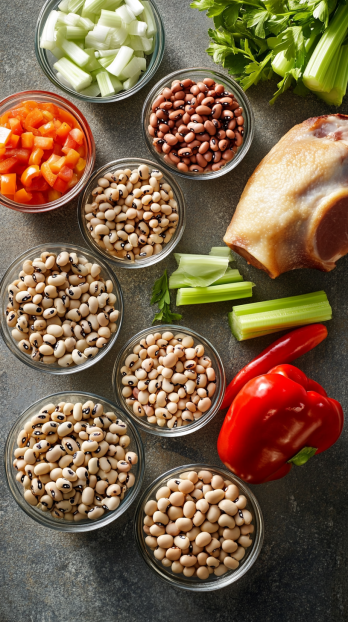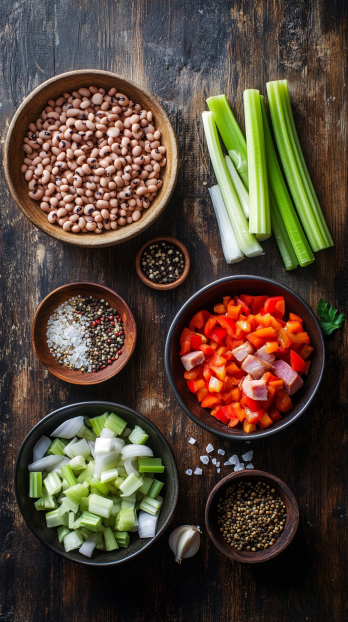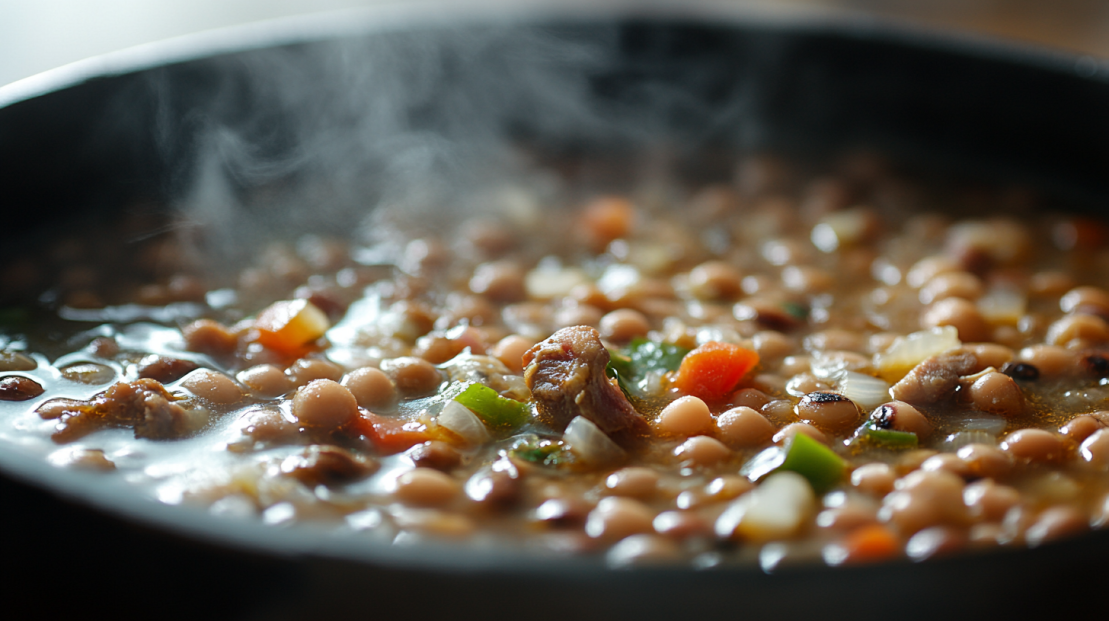New Year Black-Eyed Peas Recipe That Nobody Wants To Miss
You might be searching for a big taste that rings in fresh hope. Folks gather around the table, and they sometimes wonder why these black-eyed peas bring so much cheer. Some say luck, others say comfort, but everybody seems excited when a pot of these gems lands on the stove.
Here, we share a hearty plan: prepare them right, serve them in style, and munch your way to an uplifting start.
Read on if your belly yearns for a tradition that combines hearty peas, smoky flavors, and a soothing vibe.
A Friend In Your Kitchen
Big night, big party, and big dreams on the horizon? That’s the vibe for folks when calendars flip.
Yet, many folks get a bit lost hunting for that perfect recipe to match the occasion. Think about the anxious feeling when a tradition calls for good fortune, but the pot feels bland. That’s a real worry for many home cooks.
The heart can sink faster than a stone when you sense your peas might remain tough or plain. Some folks blame a quick soak that fails. Others might struggle with the right smoky kick. The confusion gets real if you try to guess the best cooking method. Heads spin, and you want a solution that feels effortless.
That’s where a tried-and-true pea pot can help. A warm bowl bursting with flavor, combined with a comforting aroma, soothes those jitters. Grab your apron and gather your onions, celery, bell pepper, and beloved black-eyed peas. Let’s cook up a sweet reminder: a new year deserves a dish that brightens your plate and lifts your spirit. Our plan addresses the puzzle from every angle and gives your peas the attention they deserve. Enjoy the ride, friend, and see how easy it can be.
Why Black-Eyed Peas Carry Holiday Luck
Many cooks connect these peas with grand wishes for prosperity. Some say the custom traces back to early American history. Others attribute it to older beliefs that these hearty beans invite wealth and good fortune. Whichever story you prefer, the peas have stood the test of time.
Traditions often shape daily life, and serving these peas on the first day of the year can help folks gather with purpose. Legend points to coins, happiness, and the cozy idea of starting fresh. All that matters is the little boost in morale as bowls come steaming hot to the table.
This sense of ritual makes the meal more than plain beans. You’re tapping into a shared memory, one that might stretch across generations. Kids pass it on, grown-ups adapt it, and newcomers love to join. A taste that comforts the body and soothes the mind feels just right for a new beginning.
Choosing And Preparing Your Peas

Selecting Quality Black-Eyed Peas
Some folks gravitate toward dried peas, others lean on canned, and a few even try fresh ones if they’re available in certain markets. The dried route tends to bring a deeper flavor once they simmer with a smoked ham hock or bacon. Canned peas might require less time, but that trade-off can slip away if the texture lacks that firm-yet-tender pop.
Soak Or No Soak Debate
Lots of folks wonder if an overnight soak is essential. Some find it helpful, especially if beans feel old or you suspect they’ll cook unevenly. Others simply rinse and toss them straight into the pot.
Both methods work if you track cooking time. Some folks notice that soaked peas may cook faster. But if you forget to soak them, no big meltdown occurs. They might just need an extra chunk of minutes on the heat.
Preparing And Soaking Your Beans
- Rinse Thoroughly: Inspect and pick out any debris or tiny stones.
- Optional Soak: Let the peas rest in a bowl of water for at least 6 hours, or do a quick soak by boiling them for a few minutes, then turning off the heat and letting them rest.
- Drain: Discard the soaking water to reduce the possibility of an overly starchy taste.
- Set Aside: Have your peas ready to toss in once you’ve got your aromatics going.
Some folks swear by a short soak. Others skip it entirely. Trust your preference, and let your schedule decide.
Unlocking Flavor With Key Ingredients

Essential Ingredients
- The Black-Eyed Peas
The star of the show. These peas are said to bring prosperity and have an earthy sweetness that pairs beautifully with smoky notes. - Ham Hock Or Bacon
That smoky whisper can come from a ham hock simmering away, releasing its essence. Folks who skip pork might swap for turkey wings or a vegetarian alternative with liquid smoke. - Onion, Celery, Bell Pepper
Often tagged as the trinity in Southern kitchens. They bring color, crunch, and a savory core. Onions add sweetness, celery adds a bright note, and bell peppers give a touch of mellow heat. - Garlic
Little bits of minced garlic can lift the whole dish. It loves to cozy up next to smoky flavors. - Stock (Chicken Or Vegetable)
Many folks prefer chicken stock for that full-bodied base. Others stick to vegetable stock if skipping meat. - Seasonings And Add-Ins
- Salt And Pepper: Basics that shape your taste.
- Bay Leaf: Adds a soft herbal aroma.
- Cayenne Or Chili Flakes: Sparks a gentle heat if that’s your style.
- Herbs: A hint of thyme or oregano sometimes appears, though not required.
Flavor Boosters: Ham Hocks And More
Ham hocks bring that robust, meaty essence. It’s a partnership of fat, collagen, and smoky undertones. Let them simmer with the peas, and watch the mixture transform into a comforting pot of delight. If you prefer less meaty bits, bacon pieces can work. Vegans can stir in a pinch of smoked paprika or a dash of liquid smoke. The aim is that same sense of savor.
Step-By-Step Cooking Method
Cooking Methods: Stovetop Or Slow Cooker
- Stovetop
- Brown the ham hock or bacon.
- Sauté onions, celery, and bell peppers.
- Add peas, seasonings, and stock.
- Simmer on low heat until peas turn tender.
- Slow Cooker
- Place peas, smoked meat, onions, celery, bell pepper, and garlic in the cooker.
- Pour enough stock to cover.
- Let it cook on low heat for about 6–8 hours.
Each approach captures that deep flavor. Some folks say the slow cooker method yields a soft texture without fuss, while the stovetop approach delivers more direct control and quicker adjustments.
Steps To Achieve Tender Peas
- Render The Smoky Meat
Bits of bacon or a hock create a foundation. - Sauté The Aromatics
Onion, celery, and bell pepper get translucent and sweet, letting every flavor shine. - Combine With Peas And Stock
Keep the liquid at a gentle bubble. - Cover And Gently Cook
Check every so often and give a stir so nothing scorches. - Taste, Season, And Adjust
Salt can intensify or dull out, so do little pinches until you find harmony.
Best Ways To Serve And Garnish

Serving Suggestions For Good Luck
The meal has symbolic meaning for the turning of the year. Many set out the peas with collard greens. Others pair them with cornbread. Some folks spoon them over rice, reminiscent of a popular dish known as Hoppin’ John.
Pairing With Cornbread
That golden bread, crumbly and lightly sweet, makes a handy sidekick. Picture a wedge soaking up the pot liquor (the rich, seasoned broth). The peas bounce off that slight sweetness, making each mouthful more comforting.
Finishing Touches And Garnishes
A drizzle of hot sauce, a sprinkling of green onions, or even fresh parsley can brighten the bowl. You could add shredded cheese or diced tomatoes if you crave color. Some families like crisp bacon bits on top.
Saving The Black-Eyed Peas Leftovers For Later
Tips To Store Leftovers
- Cool Down
Allow peas to rest at room temperature briefly. - Package Properly
Put them in an airtight container. - Refrigerate Or Freeze
Fridge if you’ll use them soon (up to three days), freezer if you need a longer break. - Reheat Gently
Low and slow on the stove or in the microwave. Add a splash of stock if it’s thick.
Leftovers can taste even better once the flavors mingle overnight. That second helping might perk you up on a chilly afternoon.
Make-Ahead And Freezing Tips
Some cooks prep a double batch. One portion for the New Year, and the other gets tucked away. If the pot is well-seasoned, you might discover an even richer bowl next time you thaw and warm it.
Nutritional Insights
Let’s pop in a handy table. This is an estimate and can vary:
- Calories – 220
- Protein (g) – 14
- Carbs (g) – 25
- Fat (g) – 7
- Fiber (g) – 5
- Sodium (mg) – Varies by stock/salt
Peas bring protein and fiber. The veggies add vitamins and a dash of mineral content. A ham hock or bacon may boost sodium, so you can watch your salt if that’s a concern. For those who want less meat, swapping to turkey or even a plant-based smoky option can trim the fat.
Black Eyed Peas Ingredient Alternatives
- Ham Hock Substitute: Turkey legs or wings with smoked seasoning can stand in.
- No Pork Method: Use smoked paprika or liquid smoke, then sprinkle shredded chicken if you’d still like a meaty note.
- Vegan Option: Skip all meat, use vegetable stock, add mushrooms for depth, and keep the smoky flavor from seasonings like paprika.
- Different Beans: Some folks might try pinto beans or navy beans if black-eyed peas are out of reach, though that might lose the holiday magic in the minds of purists.
New Year Black-Eyed Peas Recipe
Print
New Year’s Black-Eyed Peas Recipe with a Honey Twist
- Prep Time: 15 minutes
- Cook Time: 60 minutes
- Total Time: 1 hour 15 minutes
- Yield: 8 Servings 1x
- Category: Main or Side
- Method: Stovetop
- Cuisine: Southern
Description
Hearty, smoky black-eyed peas simmered with onion, celery, and bell pepper. A small drizzle of honey near the finish adds a mild sweet note that makes this dish one-of-a-kind on the holiday table.
Equipment
- Large heavy-bottomed pot or Dutch oven
- Wooden spoon for stirring
- Measuring cups and spoons
- Cutting board and sharp knife
Ingredients
- 1 pound dried black-eyed peas, rinsed (soak overnight if desired)
- 1 smoked ham hock (or 6 strips of thick-cut bacon, chopped)
- 1 large onion, diced
- 1 green bell pepper, diced
- 2 celery stalks, diced
- 2 garlic cloves, minced
- 4 cups chicken stock (plus extra water if needed)
- 1 teaspoon salt (adjust to taste)
- 1/2 teaspoon black pepper
- 1/2 teaspoon cayenne pepper (optional for a gentle kick)
- 1 bay leaf
- 1 tablespoon honey (the special twist)
- Optional garnish: chopped green onions or parsley
Instructions
- Warm the Pot
- Place your pot or Dutch oven on medium heat. Drop in the ham hock (or bacon) and allow it to render. Stir occasionally so it doesn’t stick.
- Sauté Aromatics
- Add onion, bell pepper, and celery. Cook for several minutes until the onions become translucent and the peppers soften. Slide in the minced garlic and let it mingle for about 30 seconds.
- Combine Peas and Stock
- Add the black-eyed peas along with the bay leaf. Pour in chicken stock, ensuring the peas are covered by about an inch of liquid. Stir gently to combine.
- Simmer and Season
- Bring the pot to a gentle bubble, then reduce heat to low and cover partway. Keep an eye on the liquid level. If it dips too low, add a splash of water or more stock.
- Simmer until the peas turn tender, somewhere around 40–60 minutes. Taste as you go to decide the perfect texture.
- Add the Final Touch
- Once the black-eyed peas reach a creamy consistency, stir in salt, black pepper, and a dash of cayenne. Drizzle in the honey. This subtle sweet element balances the smoky notes and sets this recipe apart.
- Adjust seasonings to suit your taste.
- Finish and Serve
- Fish out the bay leaf and remove the ham hock. Shred any remaining meat from the bone, then stir it back in.
- Sprinkle with chopped green onions or parsley if you like a fresh pop of color. Enjoy with cornbread, collards, or your favorite holiday sides.
Notes
- The honey adds a bit of sweetness that highlights the savory ham and peppers. This twist helps the peas feel just a touch fresher and brings a pleasing contrast to the smoky flavors.
- If you prefer a thicker consistency, lightly mash some of the peas in the pot.
- Leftovers store well in the fridge for up to three days. A reheat on low heat with a splash of water is all you need.
Nutrition
- Serving Size: 1 Serving
- Calories: 220
- Sodium: Varies by stock/salt
- Fat: 7
- Carbohydrates: 25
- Fiber: 5
- Protein: 14
Folk Tales And Good Fortune
Long ago, people claimed peas offered pennies, greens suggested dollars, and cornbread symbolized gold. That story charms folks who gather to stir the pot. The comfort behind these old beliefs lingers even if one isn’t strongly superstitious.
Kids sometimes argue about the number of peas they must eat for luck, while elders say even one spoonful can do the trick. The bigger goal might be to share a joyful tradition that fosters unity.
Serving Family-Style
Lug the big pot to the table, set out warm bread, and invite everyone to scoop as much as they fancy. That communal feeling can stir up smiles. Some families add a small side of fresh onion slices, others pop pickled peppers on the table. Let the mood guide your choices.
When the steam rises, folks can pass jokes around. Maybe a toast to health or a quick reflection on the past year. It’s all about that sense of togetherness that food brings.
Frequently Asked Questions
Simmer gently and test them for doneness. Too much heat can break them down. A lower flame plus a covered pot helps you prevent overcooking.
Yes, they’re often quite convenient. Keep an eye on the texture, and cook them until soft. They usually need less time than dried peas.
Many folks skip it. You might need a bit more time to get them tender. Soaking is optional, not locked in stone.
Absolutely. Sprinkle a dash of cayenne or chili flakes at the end. If folks prefer milder flavors, keep the spiciness in a side sauce or topping.
You can swap in smoked turkey or use a veggie approach with some smoky spices. The essence remains similar: a cozy bean pot with comfort vibes.
They usually thicken as they cook. If you want an even creamier texture, mash a small portion right in the pot, or simmer them a bit longer uncovered.
Three days in the fridge remains safe. After that, pop them in the freezer. Freezer storage can last a couple of months before flavors diminish.
The Final Bite
We love how a simple pot of black-eyed peas can bring together friends, family, and the spirit of new beginnings. Steam drifting through the kitchen, a gentle hum of excited chatter, and a classic tradition that keeps folks feeling connected.
Go for that first bite, and see if your heart doesn’t warm a bit. Happy cooking, and may your new year feel brimming with promise.
Disclosure: This article uses automation for structure, but all insights and advice are provided by Ryan Yates, an experienced executive chef with over 20 years of expertise. Additionally, this post may contain affiliate links, which means we may earn a small commission if you purchase through them, at no extra cost to you. This helps support our work and allows us to keep providing high-quality content.


